Theoretical Prediction of the Monolayer Hf2Br4 as Promising Thermoelectric Material
Abstract
:1. Introduction
2. Computational Details
3. Results and Discussions
3.1. Stability and Electronic Structure
3.2. Thermal Transport Properties
3.3. Electronic Transport Properties
3.4. Thermoelectric Properties
4. Conclusions
Author Contributions
Funding
Institutional Review Board Statement
Informed Consent Statement
Data Availability Statement
Acknowledgments
Conflicts of Interest
References
- Ma, Z.; Wei, J.; Song, P.; Zhang, M.; Yang, L.; Ma, J.; Liu, W.; Yang, F.; Wang, X. Review of experimental approaches for improving zT of thermoelectric materials. Mater. Sci. Semicon. Proc. 2021, 121, 105303. [Google Scholar] [CrossRef]
- Iversen, B.B. Breaking thermoelectric performance limits. Nat. Mater. 2021, 20, 1309–1310. [Google Scholar] [CrossRef] [PubMed]
- Zhang, X.; Guo, Y.; Zhou, Z.; Li, Y.; Chen, Y.; Wang, J. A general strategy for designing two-dimensional high-efficiency layered thermoelectric materials. Energy Environ. Sci. 2021, 14, 4059–4066. [Google Scholar] [CrossRef]
- Grauby, S.; Ben Amor, A.; Hallais, G.; Vincent, L.; Dilhaire, S. Imaging Thermoelectric Properties at the Nanoscale. Nanomaterials 2021, 11, 1199. [Google Scholar] [CrossRef]
- Li, D.; Gong, Y.; Chen, Y.; Lin, J.; Khan, Q.; Zhang, Y.; Li, Y.; Zhang, H.; Xie, H. Recent Progress of Two-Dimensional Thermoelectric Materials. Nano-Micro Lett. 2020, 12, 36. [Google Scholar] [CrossRef] [Green Version]
- Ul Haq, B.; Alfaify, S.; Alshahrani, T.; Ahmed, R.; Mahmood, Q.; Hoat, D.M.; Tahir, S.A. Investigations of thermoelectric properties of ZnO monolayers from the first-principles approach. Phys. E Low-Dimens. Syst. Nanostruct. 2021, 126, 114444. [Google Scholar] [CrossRef]
- Cui, Y.; Duan, S.; Chen, X.; Yang, M.; Yang, B.; Yi, W.; Liu, X. Prediction of enhanced thermoelectric performance in two-dimensional black phosphorus nanosheets. Vacuum 2021, 183, 109790. [Google Scholar] [CrossRef]
- Huang, H.H.; Fan, X.; Singh, D.J.; Zheng, W.T. Thermoelectric properties of monolayer GeAsSe and SnSbTe. J. Mater. Chem. C 2020, 8, 9763–9774. [Google Scholar] [CrossRef]
- Terada, T.; Uematsu, Y.; Ishibe, T.; Naruse, N.; Sato, K.; Nguyen, T.Q.; Kobayashi, E.; Nakano, H.; Nakamura, Y. Giant Enhancement of Seebeck Coefficient by Deformation of Silicene Buckled Structure in Calcium-Intercalated Layered Silicene Film. Adv. Mater. Interfaces 2022, 9, 2101752. [Google Scholar] [CrossRef]
- Kumar, S.; Schwingenschlögl, U. Thermoelectric Response of Bulk and Monolayer MoSe2 and WSe2. Chem. Mater. 2015, 27, 1278–1284. [Google Scholar] [CrossRef]
- Uematsu, Y.; Terada, T.; Sato, K.; Ishibe, T.; Nakamura, Y. Low thermal conductivity in single crystalline epitaxial germanane films. Appl. Phys. Express 2020, 13, 55503. [Google Scholar] [CrossRef]
- Jiao, W.Y.; Hu, R.; Han, S.H.; Luo, Y.F.; Yuan, H.M.; Li, M.K.; Liu, H.J. Surprisingly good thermoelectric performance of monolayer C3N. Nanotechnology 2021, 33, 45401. [Google Scholar] [CrossRef] [PubMed]
- Qi, H.; Sun, Z.; Wang, N.; Qin, G.; Zhang, H.; Shen, C. Two-dimensional Al2I2Se2: A promising anisotropic thermoelectric material. J. Alloys Compd. 2021, 876, 160191. [Google Scholar] [CrossRef]
- Wang, Y.; Gao, Z.; Zhou, J. Ultralow lattice thermal conductivity and electronic properties of monolayer 1T phase semimetal SiTe2 and SnTe2. Phys. E Low-Dimens. Syst. Nanostruct. 2019, 108, 53–59. [Google Scholar] [CrossRef] [Green Version]
- Sun, Z.; Yuan, K.; Chang, Z.; Bi, S.; Zhang, X.; Tang, D. Ultra-low thermal conductivity and high thermoelectric performance of two-dimensional triphosphides (InP3, GaP3, SbP3 and SnP3): A comprehensive first-principles study. Nanoscale 2020, 12, 3330–3342. [Google Scholar] [CrossRef]
- Fan, Q.; Yang, J.; Qi, H.; Yu, L.; Qin, G.; Sun, Z.; Shen, C.; Wang, N. Anisotropic thermal and electrical transport properties induced high thermoelectric performance in an Ir2Cl2O2 monolayer. Phys. Chem. Chem. Phys. 2022, 24, 11268–11277. [Google Scholar] [CrossRef]
- Robin Chang, Y.H.; Yoon, T.L.; Yeoh, K.H.; Lim, T.L. Integrated SnSSe bulk and monolayer as industrial waste heat thermoelectric materials. Int. J. Energy Res. 2021, 45, 2085–2099. [Google Scholar] [CrossRef]
- Shi, W.; Ge, N.; Wang, X.; Wang, Z. High Thermoelectric Performance of Sb2Si2Te6 Monolayers. J. Phys. Chem. C 2021, 125, 16413–16419. [Google Scholar] [CrossRef]
- Gupta, R.; Dongre, B.; Carrete, J.; Bera, C. Thermoelectric properties of the SnS monolayer: Fully ab initio and accelerated calculations. J. Appl. Phys. 2021, 130, 54301. [Google Scholar] [CrossRef]
- Sarikurt, S.; Kocabaş, T.; Sevik, C. High-throughput computational screening of 2D materials for thermoelectrics. J. Mater. Chem. A 2020, 8, 19674–19683. [Google Scholar] [CrossRef]
- Kresse, G.; Furthmuller, J. Efficient iterative schemes for ab initio total-energy calculations using a plane-wave basis set. Phys. Rev. B Condens. Matter 1996, 54, 11169–11186. [Google Scholar] [CrossRef] [PubMed]
- Kresse, G.; Joubert, D. From ultrasoft pseudopotentials to the projector augmented-wave method. Phy. Rev. B 1999, 59, 1758–1775. [Google Scholar] [CrossRef]
- Krukau, A.V.; Vydrov, O.A.; Izmaylov, A.F.; Scuseria, G.E. Influence of the exchange screening parameter on the performance of screened hybrid functionals. J. Chem. Phys. 2006, 125, 224106. [Google Scholar] [CrossRef] [PubMed]
- Madsen, G.K.H.; Carrete, J.; Verstraete, M.J. BoltzTraP2, a program for interpolating band structures and calculating semi-classical transport coefficients. Comput. Phys. Commun. 2018, 231, 140–145. [Google Scholar] [CrossRef] [Green Version]
- Cai, Y.; Zhang, G.; Zhang, Y. Polarity-Reversed Robust Carrier Mobility in Monolayer MoS2 Nanoribbons. J. Am. Chem. Soc. 2014, 136, 6269–6275. [Google Scholar] [CrossRef] [Green Version]
- Long, M.; Tang, L.; Wang, D.; Li, Y.; Shuai, Z. Electronic Structure and Carrier Mobility in Graphdiyne Sheet and Nanoribbons: Theoretical Predictions. ACS Nano 2011, 5, 2593–2600. [Google Scholar] [CrossRef]
- Bardeen, J.; Shockley, W. Deformation Potentials and Mobilities in Non-Polar Crystals. Phys. Rev. 1950, 80, 72–80. [Google Scholar] [CrossRef]
- Li, W.; Carrete, J.; Katcho, N.A.; Mingo, N. ShengBTE: A solver of the Boltzmann transport equation for phonons. Comput. Phys. Commun. 2014, 185, 1747–1758. [Google Scholar] [CrossRef]
- Togo, A.; Tanaka, I. First principles phonon calculations in materials science. Scr. Mater. 2015, 108, 1–5. [Google Scholar] [CrossRef] [Green Version]
- Bafekry, A.; Yagmurcukardes, M.; Akgenc, B.; Ghergherehchi, M.; Mortazavi, B. First-principles investigation of electronic, mechanical and thermoelectric properties of graphene-like XBi (X = Si, Ge, Sn) monolayers. Phys. Chem. Chem. Phys. 2021, 23, 12471–12478. [Google Scholar] [CrossRef]
- Nag, S.; Saini, A.; Singh, R.; Kumar, R. Ultralow lattice thermal conductivity and anisotropic thermoelectric performance of AA stacked SnSe bilayer. Appl. Surf. Sci. 2020, 512, 145640. [Google Scholar] [CrossRef]
- Pichanusakorn, P.; Bandaru, P. Nanostructured thermoelectrics. Mater. Sci. Eng. R Rep. 2010, 67, 19–63. [Google Scholar] [CrossRef]
- Wrasse, E.O.; Torres, A.; Baierle, R.J.; Fazzio, A.; Schmidt, T.M. Size- effect induced high thermoelectric figure of merit in PbSe and PbTe nanowires. Phys. Chem. Chem. Phys. 2014, 16, 8114–8118. [Google Scholar] [CrossRef] [PubMed]
- Fan, D.D.; Liu, H.J.; Cheng, L.; Zhang, J.; Jiang, P.H.; Wei, J.; Liang, J.H.; Shi, J. Understanding the electronic and phonon transport properties of thermoelectric material BiCuSeO: A first-principles study. Phys. Chem. Chem. Phys. 2016, 19, 12913–12920. [Google Scholar] [CrossRef] [Green Version]
- Yang, J.; Fan, Q.; Ding, Y.; Cheng, X. Predicting thermoelectric performance of eco-friendly intermetallic compound p-type CaMgSi from first-principles investigation. J. Alloys Compd. 2018, 752, 85–92. [Google Scholar] [CrossRef]
- Li, B.; Yang, Y.; Sun, Z.; Qi, H.; Xiong, Z.; Wu, K.; Li, H.; Sun, K.; Xiao, X.; Shen, C.; et al. First-Principles Investigation on the Significant Anisotropic Thermoelectric Transport Performance of a Hf2Cl4 Monolayer. J. Phys. Chem. C 2021, 126, 525–533. [Google Scholar] [CrossRef]
- Singh, D.; Ahuja, R. Dimensionality effects in high-performance thermoelectric materials: Computational and experimental progress in energy harvesting applications. WIREs Comput. Mol. Sci. 2021, 12, e1547. [Google Scholar] [CrossRef]
- Guo, D.; Hu, C.; Xi, Y.; Zhang, K. Strain Effects to Optimize Thermoelectric Properties of Doped Bi2O2Se via Tran–Blaha Modified Becke–Johnson Density Functional Theory. J. Phys. Chem. C 2013, 117, 21597–21602. [Google Scholar] [CrossRef]
- Tan, J.; Hao, Q.; Zeng, Z.; Chen, X.; Geng, H. First-principles study of structural, electronic, and thermal conductivity properties of monolayer SrFBr. J. Phys. Chem. Solids 2021, 153, 109956. [Google Scholar] [CrossRef]
- Wang, N.; Li, M.; Xiao, H.; Gong, H.; Liu, Z.; Zu, X.; Qiao, L. Optimizing the thermoelectric transport properties of Bi2O2Se monolayer via biaxial strain. Phys. Chem. Chem. Phys. 2019, 21, 15097–15105. [Google Scholar] [CrossRef]
- Zhang, J.; Liu, X.; Wen, Y.; Shi, L.; Chen, R.; Liu, H.; Shan, B. Titanium Trisulfide Monolayer as a Potential Thermoelectric Material: A First-Principles-Based Boltzmann Transport Study. ACS Appl. Mater. Interface 2017, 9, 2509–2515. [Google Scholar] [CrossRef] [PubMed]
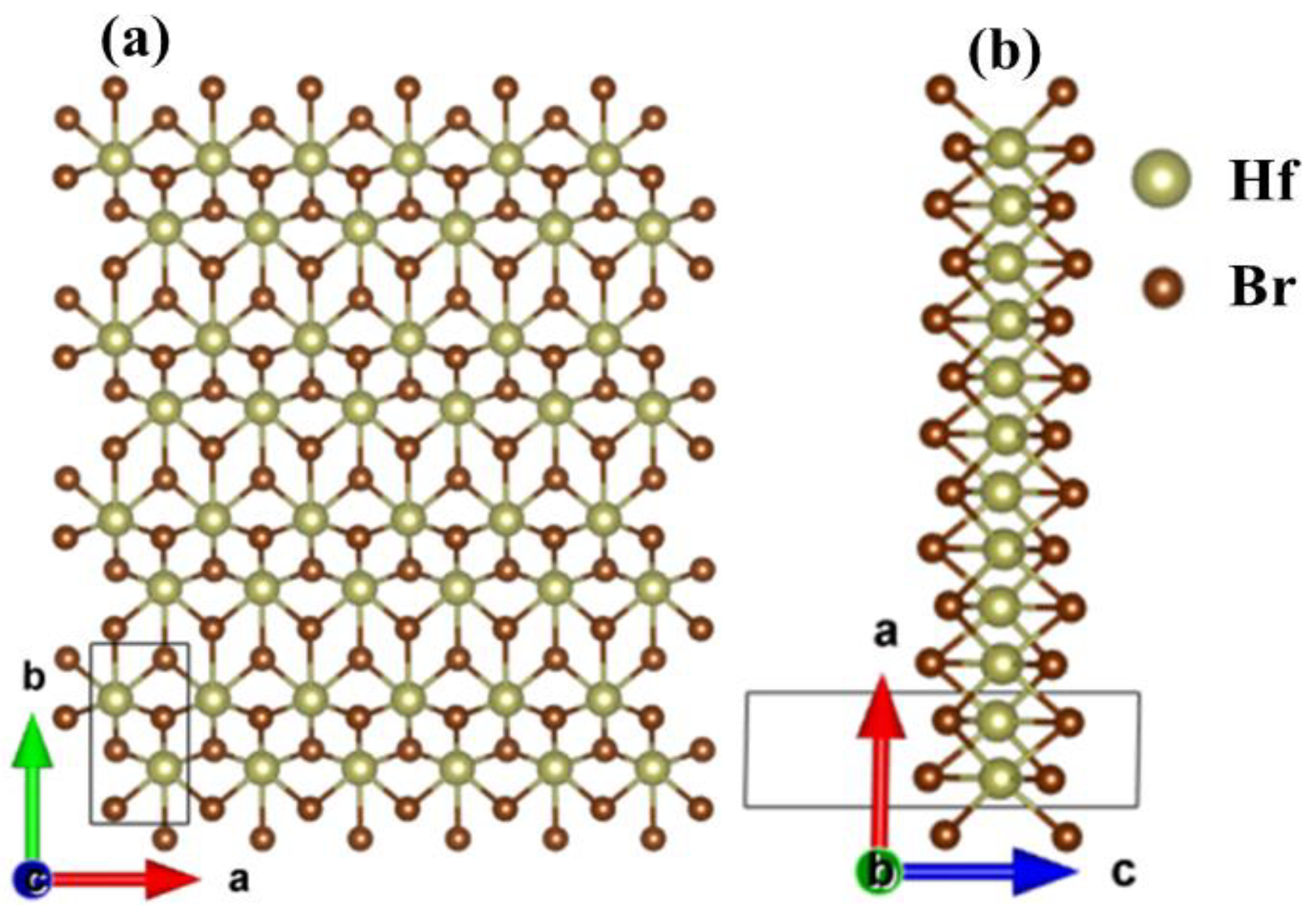
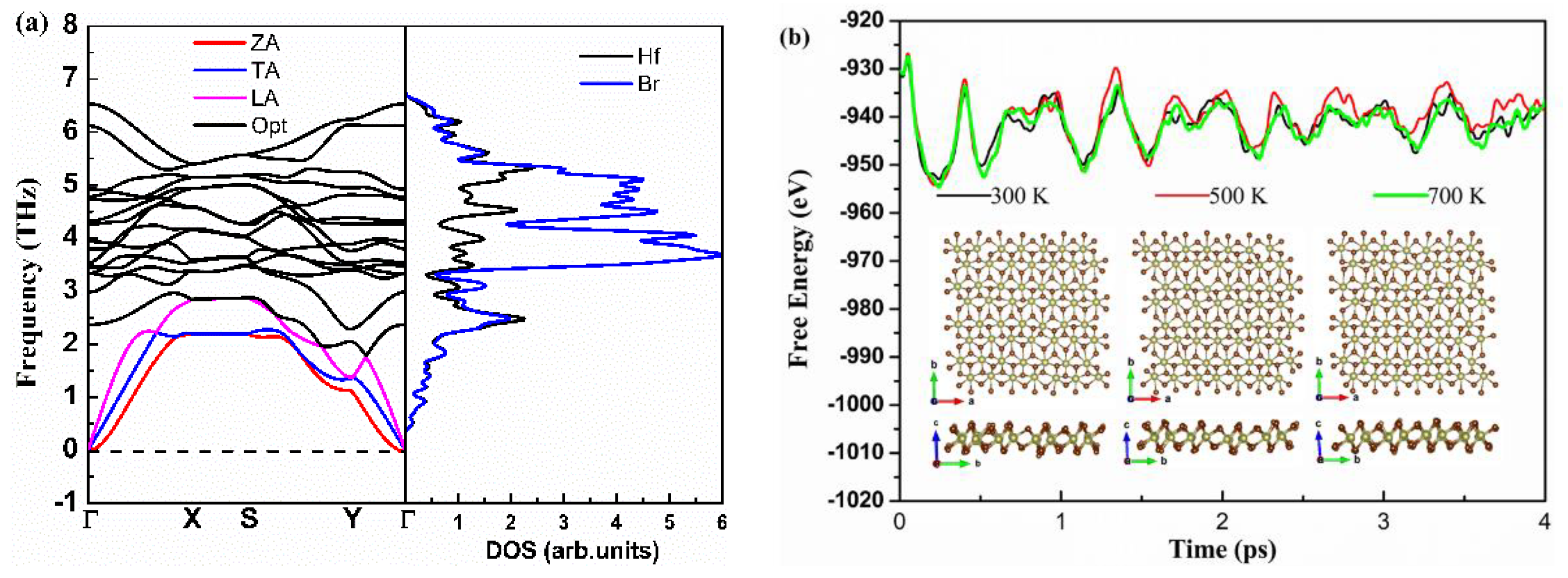
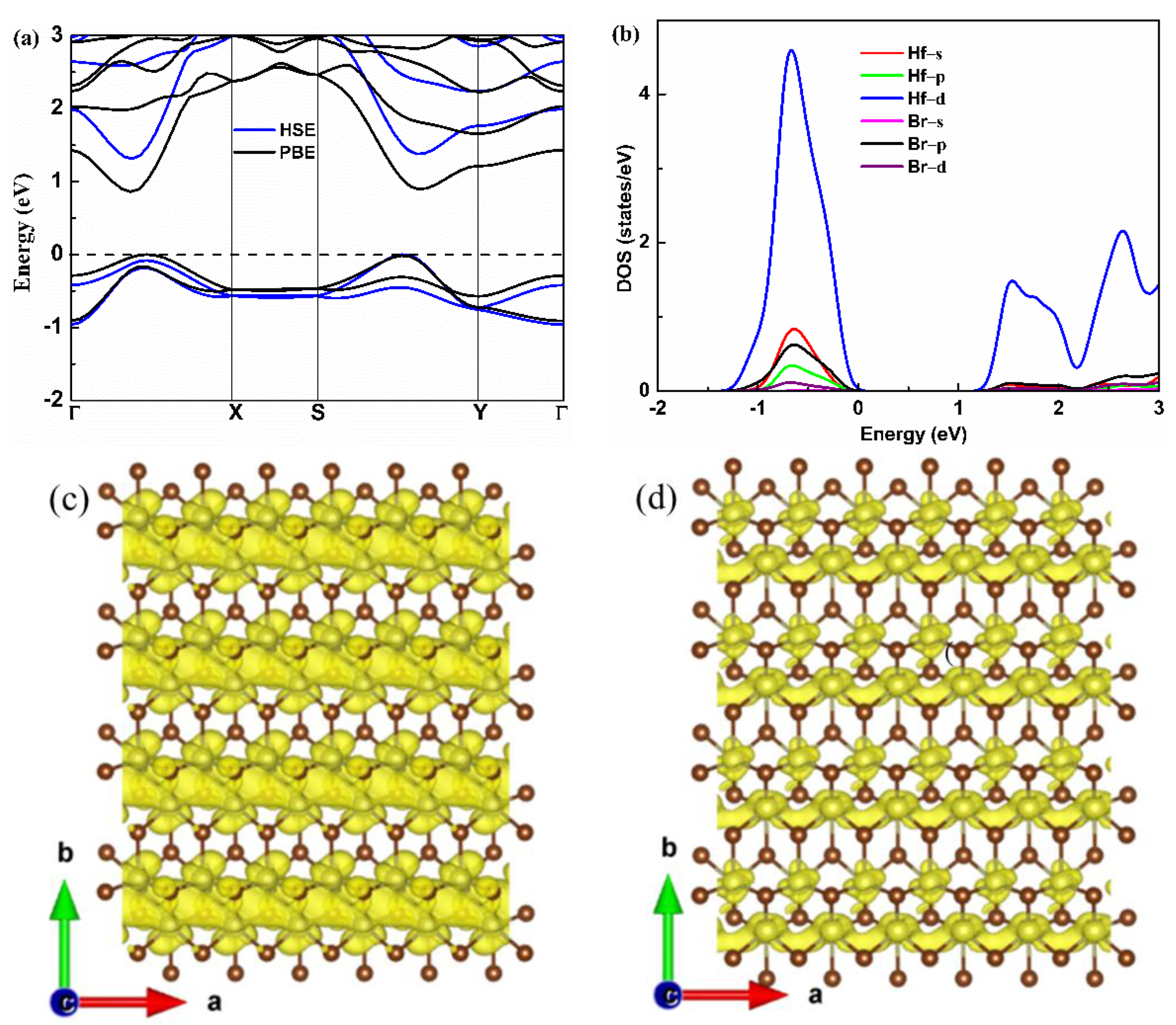

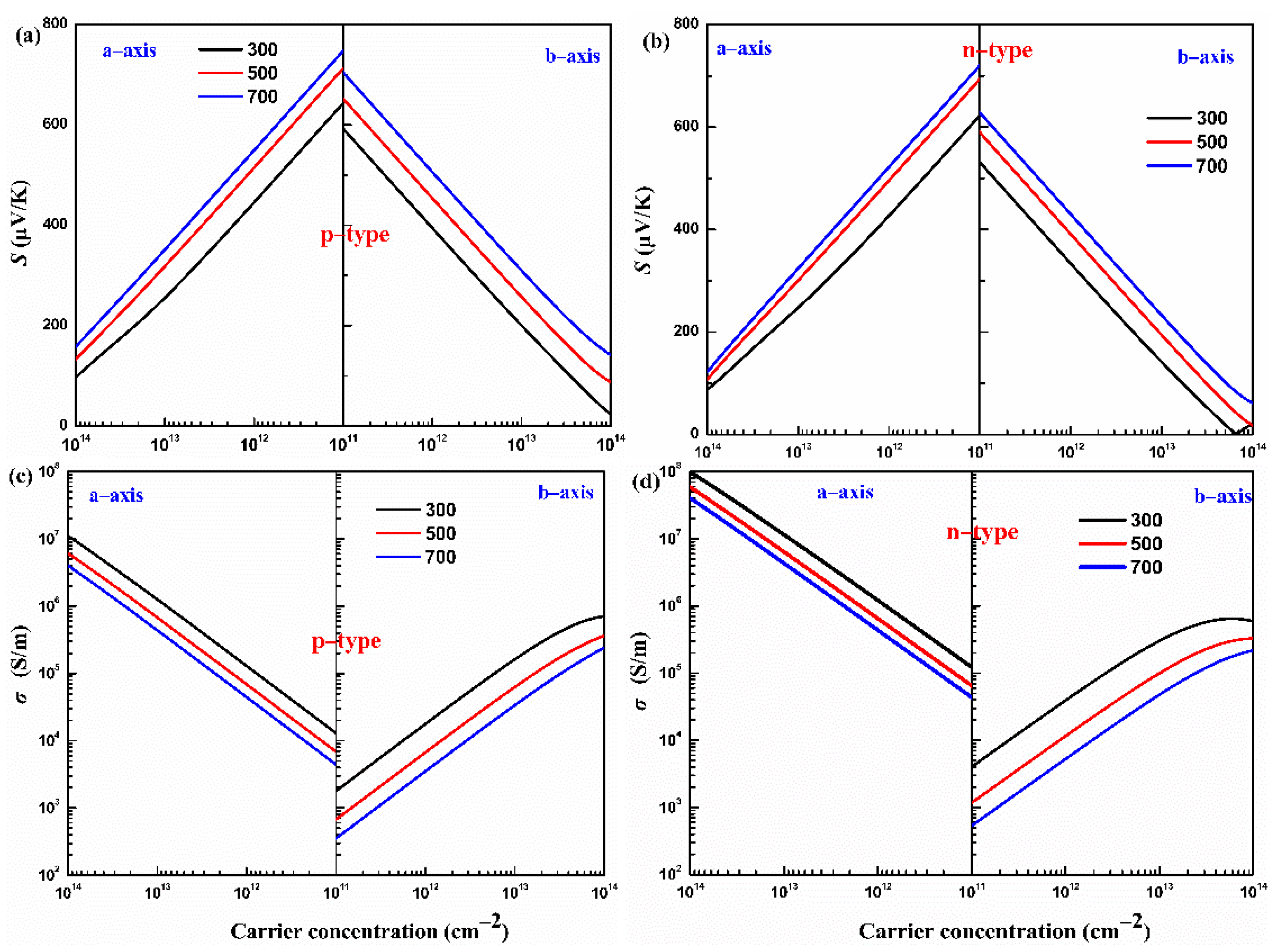
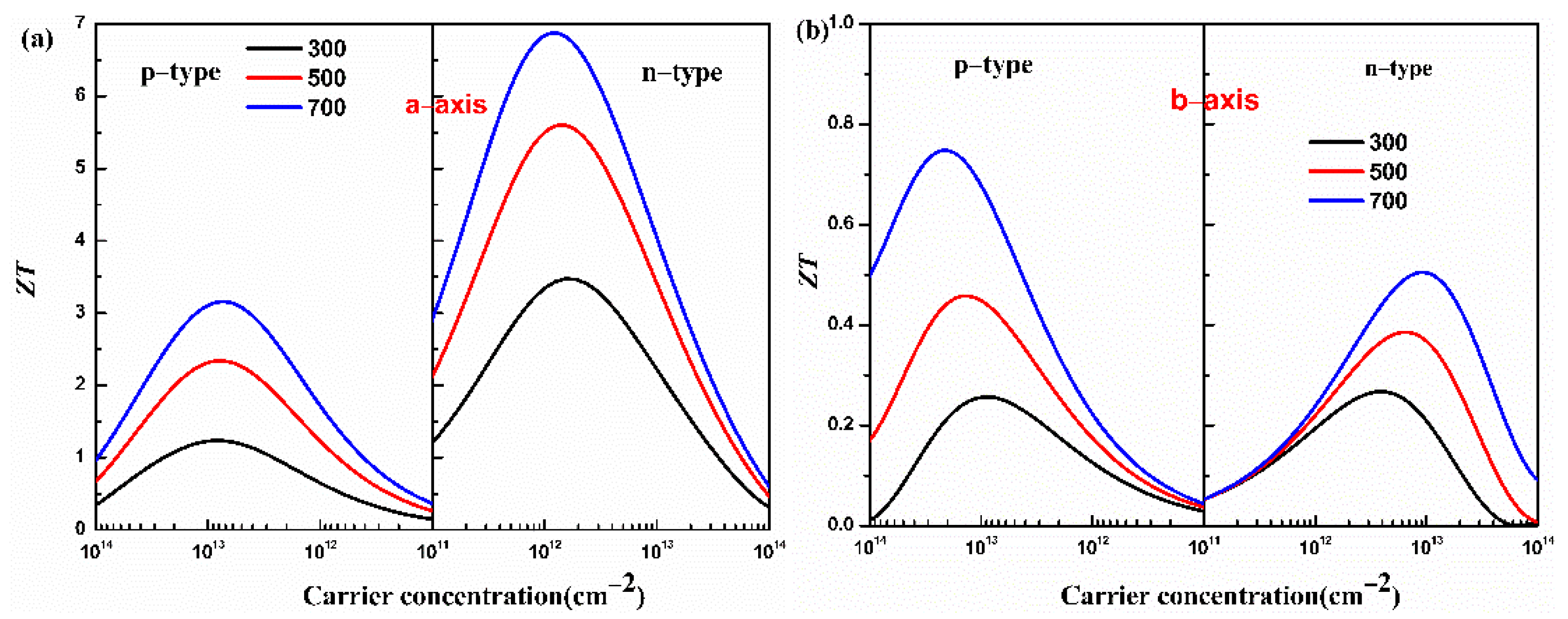
| Carrier Type | C (Jm−2) | τ (fs) | |||
|---|---|---|---|---|---|
| a-axis | p-type | 1.79 | 81.80 | 0.79 | 260.88 |
| n-type | 1.54 | 81.80 | 0.22 | 1265.62 | |
| b-axis | p-type | 0.56 | 66.89 | 1.94 | 238.63 |
| n-type | 1.08 | 66.89 | 1.61 | 1069.50 |
Publisher’s Note: MDPI stays neutral with regard to jurisdictional claims in published maps and institutional affiliations. |
© 2022 by the authors. Licensee MDPI, Basel, Switzerland. This article is an open access article distributed under the terms and conditions of the Creative Commons Attribution (CC BY) license (https://creativecommons.org/licenses/by/4.0/).
Share and Cite
Fan, Q.; Yang, J.; Wang, N. Theoretical Prediction of the Monolayer Hf2Br4 as Promising Thermoelectric Material. Materials 2022, 15, 4120. https://doi.org/10.3390/ma15124120
Fan Q, Yang J, Wang N. Theoretical Prediction of the Monolayer Hf2Br4 as Promising Thermoelectric Material. Materials. 2022; 15(12):4120. https://doi.org/10.3390/ma15124120
Chicago/Turabian StyleFan, Qiang, Jianhui Yang, and Ning Wang. 2022. "Theoretical Prediction of the Monolayer Hf2Br4 as Promising Thermoelectric Material" Materials 15, no. 12: 4120. https://doi.org/10.3390/ma15124120







